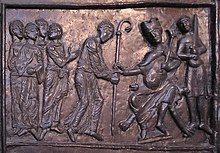Culture of medieval Poland
| Part of a series on the |
| Culture of Poland |
|---|
 |
| Traditions |
|
Mythology |
| Cuisine |
| Festivals |
| Religion |


The culture of medieval Poland was closely linked to the Catholic Church and its involvement in the country's affairs, especially during the first centuries of the Polish state's history. Many of the oldest Polish customs and artifacts date from the Middle Ages, which in Poland lasted from the late 10th to late 15th century, and were followed by the Polish Renaissance.
Early centuries (10th–12th)
The

The new customs spread as the Church also acted as the state's
Another powerful tool employed by the Church was the skill of
While
The
Late centuries (13th–15th)
From the 13th century on the culture of Poland was increasingly affected by forces other than the Church, as the nonecclesiastical institutions begun to gain importance.
The ties between Poland other countries also increased, as prospective students went abroad to

As in the West,
Architecture was not the only area of arts that boomed at that time. The patronage of wealthy and influential individuals, from kings through the nobility, as well as clergymen and town patricians, allowed various artists to create masterpieces.
The origins of Polish music can be traced as far back as the 13th century. Manuscripts from that period have been found in
-
Collegiate church in Tum, 1140–1161
-
Ołbin Monastery, Wrocław
-
Ołbin Monastery, Wrocław
-
Romanesque column with personifications of virtues inSt. Trinity-Church in Strzelno, 12th century
-
Czerwińsk
-
Kościelec church of Saint Adalbert (św.Wojciech in polish), 1231
-
Sulejów Abbey, 1232
-
Saint Martin Collegiate Church in Opatow, 1206
-
Church of St. John the Baptist inPrandocin, 12th century
-
Bolko castle in Bolków
-
Cistercian Monastery in Jędrzejów, 1140
-
Portal of theDominican Church in Sandomierz, 1236
-
Inowłódz
-
Collegiate church, Kruszwica
-
St. Nicolas Rotunda, Cieszyn
-
St. Mary's church, Inowrocław
-
Archcathedral Basilica in Poznań, 1244-1406
-
St. Mary's Basilica in Kraków, 1321–1331
-
St. John's Cathedral in Wrocław, 1244-1341
-
St. Nicholas Cathedral in Elbląg, 1247 - 14th century
See also
- History of Poland (966–1385)
- History of Poland (1385-1569)
References
- ^ Michael J. Mikoś, Polish Literature from the Middle Ages to the End of the Eighteenth Century. A Bilingual Anthology, Warsaw: Constans, 1999. Cultural background
- ^ Michael J. Mikoś, Polish Literature from the Middle Ages to the End of the Eighteenth Century. A Bilingual Anthology, Warsaw: Constans, 1999. Literary background
- Michael J. Mikoś, Polish Literature from the Middle Ages to the End of the Eighteenth Century. A Bilingual Anthology, Warsaw: Constans, 1999. Historical background
- Michael J. Mikoś, Polish Literature from the Middle Ages to the End of the Eighteenth Century. A Bilingual Anthology, Warsaw: Constans, 1999. First chapters online






















